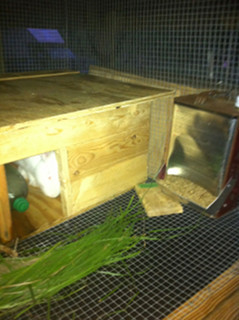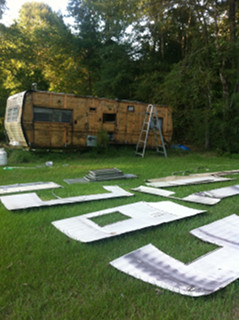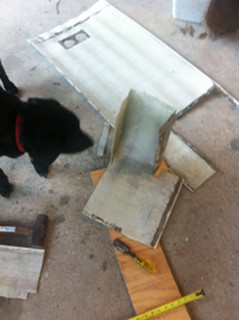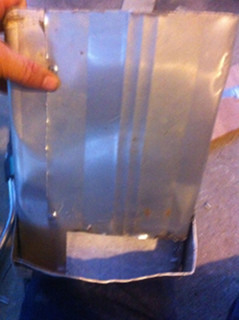
Homemade rabbit feeders
 In addition to providing
water for one's rabbits,
providing a reliable source of food is of course a necessity.
In addition to providing
water for one's rabbits,
providing a reliable source of food is of course a necessity.
We started with one rabbit
in the beginning and just used a dish to provide food for the first
couple of weeks. Since the rabbit was pretty young when we got
him, this worked OK until we could come up with a better
solution. However, I wouldn't recommend it for long term
feeding. When food is in a dish for a rabbit, there tends to be a
lot of waste due to spillage and spoiling. For whatever reason
our young buck decided that his food dish would also make a suitable
litter box. This was obviously not a sustainable situation.
Most feed stores provide
ready made rabbit feeders for anywhere from $5 on up. Most have a
screen lined bottom which is supposedly there to allow some of the dust
from the feed to fall through. Dawn has read in some library
books that this helps prevent respiratory issues with rabbits.
I'll believe the experts' advice for now, but I've found that the
screened bottom can also contribute to spoilage of food due to allowing
moisture in from the bottom. We just dealt with Hurricane Isaac
here and the one rabbit that has a store bought feeder had much of his
food spoiled from moisture being blown up through the screen. Our
other two rabbits have feeders that I've made out of materials I had
around the house.
 When Dawn brought home two new
rabbits donated to our experiment by our new neighbors, I quickly
needed to come up with some feeders for them. I already had some
ideas on building feeders inspired by Richard Proenneke and his mastery of making
complex items out of used fuel cans in the Alaskan wild. Richard
(Dick) Proenneke retired to the Alaskan wilderness in the 1970s when he
was in his 50s and has been an inspiration of mine. He built a
cabin with simple hand tools and very few materials which were not
natural and native to the area. (He lamented in his journal that
he used some plastic sheeting under the moss roof of his cabin.)
He built any number of useful items from the spent fuel cans that were
ubiquitous in the Alaskan wilderness as a result of their use by the
bush pilots. If you've seen the Coleman fuel cans in Walmart (and
in the first picture in this post), these are very similar to but a bit
smaller than what he used to make pots, pans, ovens, storage containers
and many other items.
When Dawn brought home two new
rabbits donated to our experiment by our new neighbors, I quickly
needed to come up with some feeders for them. I already had some
ideas on building feeders inspired by Richard Proenneke and his mastery of making
complex items out of used fuel cans in the Alaskan wild. Richard
(Dick) Proenneke retired to the Alaskan wilderness in the 1970s when he
was in his 50s and has been an inspiration of mine. He built a
cabin with simple hand tools and very few materials which were not
natural and native to the area. (He lamented in his journal that
he used some plastic sheeting under the moss roof of his cabin.)
He built any number of useful items from the spent fuel cans that were
ubiquitous in the Alaskan wilderness as a result of their use by the
bush pilots. If you've seen the Coleman fuel cans in Walmart (and
in the first picture in this post), these are very similar to but a bit
smaller than what he used to make pots, pans, ovens, storage containers
and many other items.
I usually have a few cans
around due to using a Coleman stove at my uncle's cabin in
Mississippi. I started out with a well cleaned fuel can for the
first of two homemade feeders. With a sturdy knife, I cut across
the wide part of the can about 4 inches up from the bottom, and then
down to the bottom from the corners. A couple of pieces of scrap
tin and a rivet gun, and I had what you see in the picture above.
On the inside is a piece of tin that is not visible which directs the
food to the trough, but also more importantly doesn't allow feed to
collect in the corners and spoil or rot. I'll have to see if I
can get a decent picture of what I am referring to, but it works pretty
well to keep the feed from spoiling.
 To replace the bowl we had been
feeding our first buck with, I used some other tin since I didn't have
an empty fuel can handy. We had recently been scrapping out an
old camper that was given to me. (See the second photo in this
post.) We will be using the frame to build a loft here for
storage, but we also ended up with a hefty supply of metal siding and
roof material.
To replace the bowl we had been
feeding our first buck with, I used some other tin since I didn't have
an empty fuel can handy. We had recently been scrapping out an
old camper that was given to me. (See the second photo in this
post.) We will be using the frame to build a loft here for
storage, but we also ended up with a hefty supply of metal siding and
roof material.
I started out with a flat
sheet of metal siding from the camper. I then started making cuts
with an old dull wood chisel and a hammer with plywood
underneath. You can see it start to take shape in the photo,
under the watchful eye of my labrador named Anna. This material
made for a very sturdy feeder once the rivets were in place.
All sharp edges on both the
fuel can and scrap tin feeders are rolled over to prevent injury to the
rabbits. Also, the feeders hold quite a bit more feed than the
store bought feeders, which helps reduce the daily upkeep we have to do
with the rabbits.
 While I could have easily
purchased several feeders from Tractor Supply for a total of about
$20-25, there is a bit of pride that comes from recycling some old
scrap material into a new life as a feeder. Also, it allowed me
to spend the hour or so I would have spent driving to the store around
the house being creative and working with my hands. I am still a
"spare time" homesteader due to a full time career, but I strongly feel
that what makes a successful homestead is the ingenuity, creativity,
and drive of the folks that give it a go. People like Richard
Proenneke (and of course friends like Anna and Mark) continue to be an
inspiration of mine. We haven't yet made a break from the rat
race, but simple things like building a rabbit feeder give us a taste
of the self sufficient life.
While I could have easily
purchased several feeders from Tractor Supply for a total of about
$20-25, there is a bit of pride that comes from recycling some old
scrap material into a new life as a feeder. Also, it allowed me
to spend the hour or so I would have spent driving to the store around
the house being creative and working with my hands. I am still a
"spare time" homesteader due to a full time career, but I strongly feel
that what makes a successful homestead is the ingenuity, creativity,
and drive of the folks that give it a go. People like Richard
Proenneke (and of course friends like Anna and Mark) continue to be an
inspiration of mine. We haven't yet made a break from the rat
race, but simple things like building a rabbit feeder give us a taste
of the self sufficient life.
Shannon and Dawn will
be sharing their experiences with raising meat rabbits on Tuesday
afternoons. They homestead on three acres in Louisiana when time off
from life and working as a sys admin permits.
Want more in-depth information? Browse through our books.
Or explore more posts by date or by subject.
About us: Anna Hess and Mark Hamilton spent over a decade living self-sufficiently in the mountains of Virginia before moving north to start over from scratch in the foothills of Ohio. They've experimented with permaculture, no-till gardening, trailersteading, home-based microbusinesses and much more, writing about their adventures in both blogs and books.
Want to be notified when new comments are posted on this page? Click on the RSS button after you add a comment to subscribe to the comment feed, or simply check the box beside "email replies to me" while writing your comment.
- Remove comment
- Remove comment
